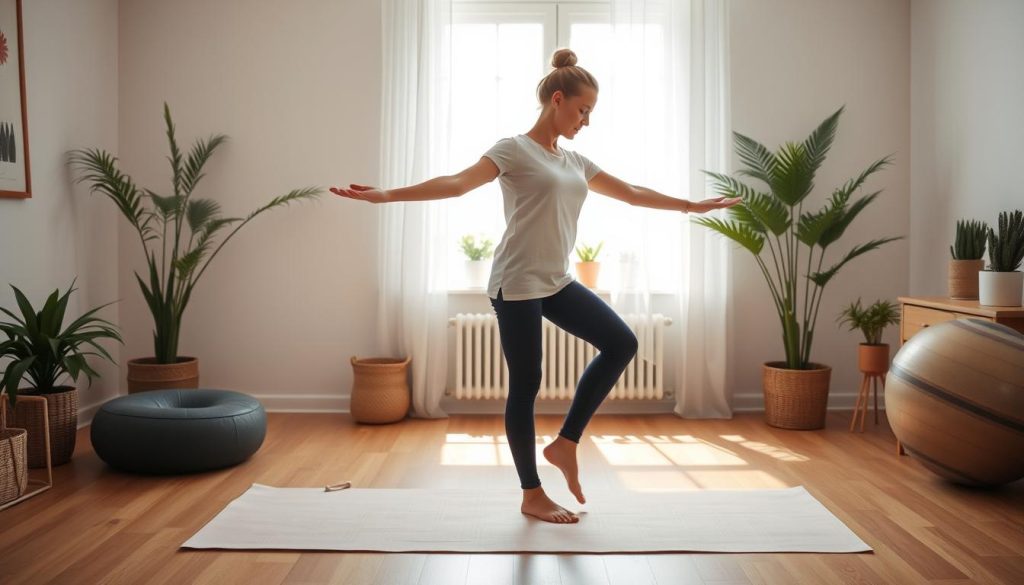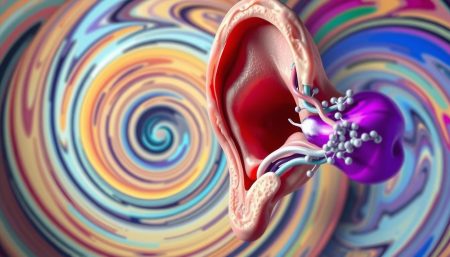Vertigo can make your world spin, literally. It affects millions, making everyday tasks hard. But, there are home remedies to help manage it.
Balance disorders can mess up your day, but knowing about vertigo is key. We’ll look at quick, home-based methods to ease symptoms. You’ll learn about repositioning and natural remedies to fight vertigo and find balance again.
Understanding Vertigo: Symptoms and Common Causes
Vertigo makes you feel like you or your surroundings are spinning. It’s more than just feeling dizzy. It can be caused by different conditions in the inner ear or brain. Let’s look at the symptoms, causes, and risk factors of this condition.
Distinguishing Vertigo from General Dizziness
Vertigo is different from general dizziness because it feels like you’re spinning. While dizziness makes you feel lightheaded, vertigo makes you feel like you’re moving. People with vertigo often say it feels like they’re on a merry-go-round or the room is tilting.
Medical Conditions Leading to Vertigo
Many medical conditions can cause vertigo. Benign paroxysmal positional vertigo (BPPV) is the most common cause. It happens when inner ear crystals move into the wrong position. Ménière’s disease, with fluid buildup in the inner ear, and vestibular neuritis, an inflammation of the vestibular nerve, are also common causes.
Risk Factors and Triggers
Certain factors can make you more likely to get vertigo:
- Age (more common in older adults)
- Head or neck injuries
- Family history of vertigo
- Migraines
- Certain medications
Common things that can trigger vertigo episodes include:
| Environmental Triggers | Physical Triggers |
|---|---|
| Sudden head movements | Stress and anxiety |
| Changes in barometric pressure | Dehydration |
| Bright or flashing lights | Lack of sleep |
Knowing these factors can help manage and prevent vertigo episodes.
The Epley Maneuver: A Proven Technique for BPPV Relief
Looking for a way to stop vertigo caused by benign paroxysmal positional vertigo (BPPV)? The Epley maneuver might be what you need. It’s a simple yet effective method that can quickly ease spinning sensations.

The Epley maneuver helps by moving loose crystals in your inner ear back into place. These crystals can cause vertigo when they’re not where they should be. By doing specific head movements, you can help these crystals find their way back.
To do the Epley maneuver:
- Sit on a bed, turning your head 45 degrees to the affected side
- Quickly lie back with your head hanging off the bed
- Wait 30 seconds
- Turn your head 90 degrees to the opposite side
- Wait another 30 seconds
- Roll onto your side, keeping your head in position
- Slowly sit up
Do this three times for the best results. Many people feel better right away after doing the Epley maneuver. It’s a safe, non-invasive way to treat BPPV at home.
“The Epley maneuver has been a game-changer for my patients with BPPV. It’s simple, effective, and can be done at home with proper guidance,” says Dr. Sarah Thompson, a leading vestibular specialist.
While the Epley maneuver is usually safe, talk to your doctor before trying it. This is especially true if you have neck or back issues. They can give you personalized advice on using this technique to fix vertigo.
How to Fix Vertigo Using Natural Home Remedies
Looking for ways to treat dizziness without a doctor’s visit? Natural home remedies can help. Let’s look at some effective options you can try at home.
Ginger-Based Solutions
Ginger is a great help for vertigo. It has anti-inflammatory properties that can ease dizziness and nausea. Try ginger tea or fresh ginger root when you feel vertigo coming on.
Essential Oils for Vertigo
Certain essential oils can help with vertigo. Peppermint, lavender, and frankincense oils are calming. Dilute these oils and apply them to your temples or neck for relief.
Hydration and Dietary Modifications
Staying hydrated is key for managing vertigo. Drink lots of water all day. Making some dietary changes can also help. Cutting down on salt and avoiding caffeine and alcohol may improve your symptoms.
| Remedy | How to Use | Benefits |
|---|---|---|
| Ginger | Tea or fresh root | Reduces dizziness and nausea |
| Essential Oils | Diluted and applied topically | Promotes relaxation and balance |
| Hydration | 8-10 glasses of water daily | Maintains inner ear fluid balance |
While these natural remedies can help, if vertigo persists, see a doctor. Always talk to a healthcare provider for a proper diagnosis and treatment plan.
Head Position Exercises for Immediate Vertigo Relief
Head position exercises can quickly help those with vertigo. They are part of vestibular rehabilitation, a therapy for balance issues. Learning these exercises can greatly improve your life.
Brandt-Daroff Exercises
Brandt-Daroff exercises are simple yet effective for vertigo. Here’s how to do them:
- Sit on the edge of your bed
- Quickly lie down on one side with your nose up at about a 45-degree angle
- Stay in this position for 30 seconds or until the dizziness goes away
- Sit up and wait for 30 seconds
- Repeat on the other side
Do this sequence 5 times, twice a day. These exercises help reposition inner ear crystals, which can cause vertigo when they move.
Semont Maneuver Steps
The Semont Maneuver is another way to fix vertigo. Here’s how to do it:
- Sit on the edge of your bed and turn your head 45 degrees to the right
- Quickly lie down on your left side
- Stay in this position for 30 seconds
- Quickly move to lie on your right side without changing your head position
- Stay in this position for 30 seconds
- Slowly return to a sitting position
Safety Precautions During Exercises
While doing these exercises, remember these safety tips:
- Make sure you have a stable surface nearby
- Move slowly to avoid falls
- Stop if you feel severe dizziness or nausea
- Talk to a healthcare professional before starting any new exercise
Consistency is important in vestibular rehabilitation. Regularly practicing these exercises can greatly improve your symptoms and help you manage vertigo effectively.
Lifestyle Changes to Prevent Vertigo Episodes
Making simple changes to your daily routine can help reduce vertigo episodes. By addressing common causes and improving balance, you can control your health better.
Managing stress is key to preventing balance disorders. Try deep breathing or meditation to keep stress down. Also, getting enough sleep is crucial, as tiredness can lead to vertigo.
Regular exercise strengthens your body and improves balance. Low-impact activities like swimming or tai chi are great. Don’t forget to drink plenty of water, as dehydration can cause dizziness and vertigo.
Identifying and avoiding personal triggers is important for managing vertigo. Keep a journal to track things like certain foods, weather changes, or specific movements.
“Small lifestyle changes can make a big difference in managing vertigo. Consistency is key to seeing long-term improvements.”
Here’s a table outlining lifestyle modifications to help prevent vertigo episodes:
| Area | Recommendation | Benefit |
|---|---|---|
| Diet | Limit salt and caffeine intake | Reduces fluid retention and inner ear pressure |
| Exercise | 30 minutes of moderate activity daily | Improves balance and overall health |
| Sleep | Aim for 7-9 hours nightly | Reduces fatigue-related vertigo risks |
| Stress | Practice mindfulness or yoga | Lowers stress-induced vertigo episodes |
By making these lifestyle changes, you can manage vertigo and improve your life. Always talk to a healthcare professional for advice on managing balance disorders.
Medical Treatments and Professional Interventions
When home remedies don’t work, seeing a doctor is key for vertigo treatment. Doctors use different methods to find and fix the root cause of vertigo. They also work to lessen the symptoms.
Prescription Medications
Doctors might give you medicine to help with vertigo. This could be antihistamines, anticholinergics, or benzodiazepines. Sometimes, diuretics or steroids are used to lower fluid in the inner ear.
Vestibular Rehabilitation Therapy
Vestibular rehabilitation is a special kind of physical therapy. It’s designed to improve balance and reduce dizziness. The therapy includes exercises made just for you, helping your brain adjust to changes in your vestibular system.

- Gaze stabilization exercises
- Balance training
- Habituation exercises
- Canalith repositioning maneuvers
Surgical Options for Severe Cases
In rare cases, surgery might be needed for vertigo that doesn’t get better with other treatments. These surgeries are usually for conditions like Meniere’s disease or acoustic neuroma.
| Surgical Procedure | Condition Treated | Success Rate |
|---|---|---|
| Endolymphatic sac decompression | Meniere’s disease | 60-80% |
| Labyrinthectomy | Severe unilateral vestibular dysfunction | 90-95% |
| Vestibular nerve section | Intractable vertigo | 85-90% |
Medical treatments offer hope for those with ongoing vertigo. From medicines to vestibular therapy and surgery, these options aim to bring back balance and better life quality.
Alternative Therapies for Managing Vertigo
Many people try alternative therapies to help with vertigo and balance issues. These methods can work alongside traditional treatments. They offer relief for some. Let’s look at a few popular options that help with dizziness.
Acupuncture Benefits
Acupuncture, an ancient Chinese practice, might help with vertigo. It involves putting thin needles into certain body points. Some people say it improves balance and lessens dizziness.
Yoga Poses for Balance
Some yoga poses can make your core stronger and balance better. Tree pose, mountain pose, and warrior pose are great for stability. Doing yoga regularly might make vertigo happen less often and improve body awareness.
Mindfulness and Relaxation Techniques
Stress can make vertigo worse. Mindfulness meditation and deep breathing can help manage stress. These practices might lessen balance disorders and help you feel calm when dizzy.
| Alternative Therapy | Potential Benefits | Frequency |
|---|---|---|
| Acupuncture | Reduced dizziness, improved balance | 1-2 sessions per week |
| Yoga | Enhanced stability, body awareness | 3-4 times per week |
| Mindfulness | Stress reduction, symptom management | Daily practice |
These alternative therapies might help with dizziness, but always talk to a healthcare provider first. They can help decide if these treatments are right for you.
Emergency Response: When to Seek Medical Help
Many vertigo causes can be handled at home. But, some need immediate medical help. Severe headaches, sudden vision changes, or long-lasting dizziness are warning signs. They might mean a serious condition that needs a doctor’s check-up.
Labyrinthitis, an inner ear infection, can cause intense vertigo. If you have hearing loss and dizziness, get medical help fast. These symptoms could mean labyrinthitis or another ear issue that needs quick treatment.
Don’t ignore signs like fainting, chest pain, or trouble speaking with vertigo. These could signal a stroke or heart problem. Call emergency services right away. Quick action is key when dealing with severe vertigo symptoms.
FAQ
Q: What is vertigo and how does it differ from general dizziness?
A: Vertigo is a type of dizziness where you feel like you or your surroundings are spinning. It’s different from general dizziness. Vertigo often comes from problems in the inner ear or brain.
Q: What are the most common causes of vertigo?
A: Common causes of vertigo include Benign Paroxysmal Positional Vertigo (BPPV), Ménière’s disease, vestibular neuritis, and labyrinthitis. Other causes can be migraines, head or neck injuries, certain medicines, and rarely, brain tumors or strokes.
Q: How can I perform the Epley Maneuver at home?
A: To do the Epley Maneuver at home for BPPV, start by sitting on a bed. Turn your head 45 degrees to the affected side. Then, lie back with your head hanging off the bed and wait 30 seconds.
Turn your head 90 degrees to the opposite side and wait another 30 seconds. Finally, turn your body to that side and sit up slowly. It’s best to have someone help you the first time.
Q: What natural remedies can help alleviate vertigo symptoms?
A: Natural remedies for vertigo include ginger, peppermint or lavender essential oils, staying hydrated, and reducing salt intake. Always talk to a healthcare provider before trying new treatments.
Q: Are there exercises I can do at home to relieve vertigo?
A: Yes, you can do exercises at home for vertigo relief. The Brandt-Daroff exercises and the Semont Maneuver are examples. These exercises help move crystals in your inner ear that may cause vertigo.
Q: What lifestyle changes can help prevent vertigo episodes?
A: To prevent vertigo, manage stress, get good sleep, and do gentle exercise. Avoid triggers and stay hydrated. Also, eat well and see your doctor regularly.
Q: When should I seek medical help for vertigo?
A: Seek medical help if you have severe headache, double vision, trouble speaking, weakness, or loss of consciousness with vertigo. Also, if vertigo is very bad, lasts a long time, or gets in the way of your daily life, see a doctor.
Q: Can vestibular rehabilitation therapy help with chronic vertigo?
A: Yes, vestibular rehabilitation therapy can help with chronic vertigo. It’s a special physical therapy to help your brain with inner ear problems. It improves balance and reduces dizziness. A therapist will create a plan just for you.
Q: Are there any alternative therapies that can help manage vertigo?
A: Yes, alternative therapies like acupuncture, yoga, and mindfulness can help with vertigo. They can improve balance and reduce dizziness. Always talk to a healthcare provider before trying new treatments.


















